Archive for November, 2013
November 30th, 2013 by dave dorsey

Intrepid art lovers properly attired outside the Frick, in 20 degree chill with 40 mph gusts of wind. Some waited an hour.
More than ten percent of all 34 (maybe 35) Vermeers in existence are on view right now at The Frick. It’s a little show, a tour of 15 paintings from the Dutch Golden Age, on loan from The Hague, yet it’s a powerful and enlightening one. I’ve seen about half of all Vermeers in the world. The Metropolitan offered 15 of them in 2001 and then The Milkmaid, all by her ownself, in 2009. So, yeah, maybe I could have skipped this one. I hear that. But this show taught me a thing or two, or three, about Hals and Rembrandt, and introduced me to Jan Steen, whose work felt the most contemporary, out of everything in the show. Plus the goldfinch Donna Tartt is making famous at the moment. Most of all, though, when you surround this show with The Frick’s permanent collection, it’s a rare chance to see four Vermeers at once, and it’s a truth universally acknowledged that one can never get too much of Vermeer. The Girl with a Pearl Earring has a room all to herself, as The Milkmaid did. In the room adjacent are the three from the permanent collection. I hope to write at more length about what I saw here when the necessity of word smithing for my supper lightens up, if ever.
I stood in line for 40 minutes with at least 60 other shivering and likemindedly unhinged art lovers last week, with temperatures around 20 in New York City, and 40 mph gusts driving wind chills down to around zero. With my typical worldly foresight, I wore a wool sweater covered with a fleece, clothing options that should have sentenced me to the fate of this frog. But to my credit I thought to climb into some thermal underwear at the last minute before my friends and I headed into the city from New Jersey. ( I’d brought the underwear in case I decided on an outdoor run in the morning.) It felt as if those skivvies saved my ass, as well as a few other more expendable parts. Bottom line: the show was worth the painful wait. What did we learn this week? Most of that, that even old, old art, if it’s great, still draws crowds that require scheduled admission into a museum. Give the human race a chance, and it will always make you believe that what once mattered still matters. Makes me want to paint, right?
November 26th, 2013 by dave dorsey
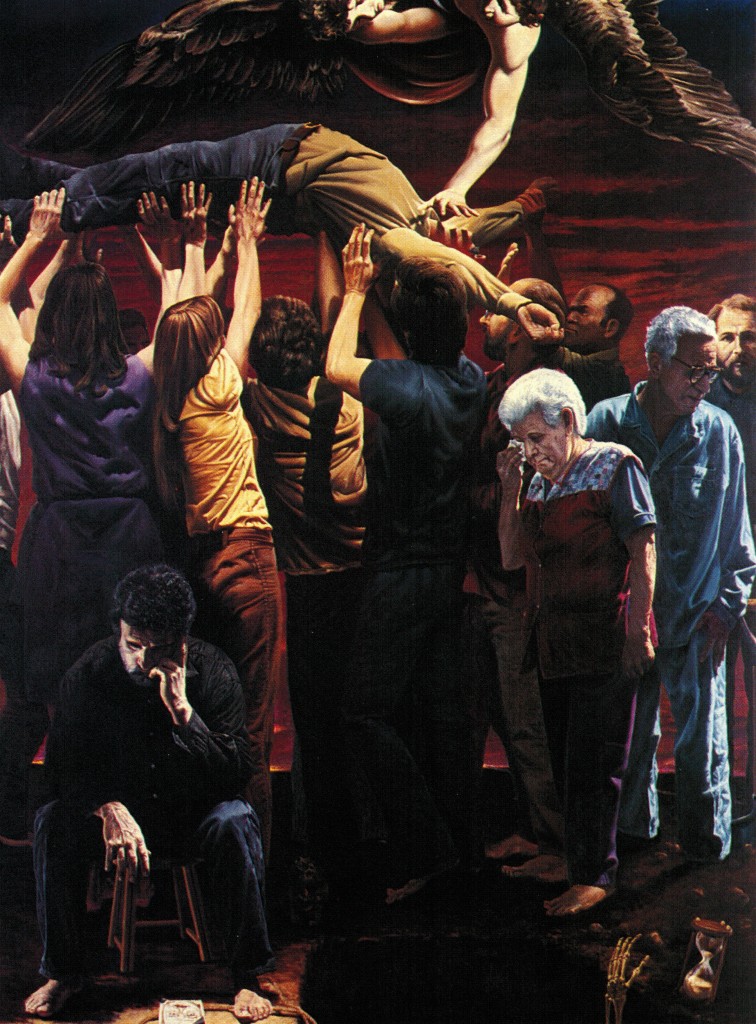
Dedication No. 3, Tom Insalaco, oil in canvas, 104″ x 79″
Hoping to get a look at the actual painting soon at Tom’s studio in Canandaigua. It’s one of three monumental oils he did a couple decades ago, while he was still wrestling with the absurd murder of his brother, Robert, a deputy sheriff who was serving a warrant in 1987. Tom’s brother died instantly when the naked suspect opened the door and shot him in the head. This painting’s full title: Dedication No. 3, Man’s final resting place is in the hearts and minds of other men.
November 24th, 2013 by dave dorsey
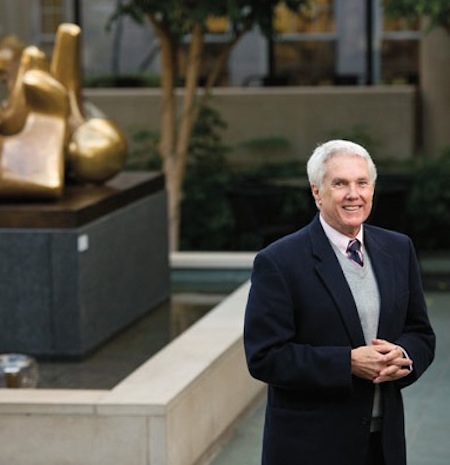
Grant Holcomb, director, Memorial Art Gallery
I learned yesterday that Grant Holcomb is retiring from his position as director of the Memorial Art Gallery here in Rochester, after nearly thirty years of service to the museum. He’s been ambivalent about concluding his tenure at MAG for many years, but now that he’s pulled the trigger he sounds happy to embark on his next chapter. And he isn’t completely disappearing from the organization. He’s going to stay in Rochester, continue to participate with MAG and, well, write a few books. Speaking of next chapters. (By the way, thanks for making me feel like a slacker, Grant.) What surprised me is that only one of his books will be about art: a catalog exploring the 2009 MAG exhibition “Lincoln in Rochester.” That’s definitely up his alley. He’s been a Lincoln geek, in the best sense of that word, for most of his life, and he can summon up almost anything about America’s greatest president at will. One of the other books he’s planning will be about Ed Crone, a Rochester man who was a prisoner of war with Kurt Vonnegut in Germany and became the inspiration for Billy Pilgrim in Slaughterhouse Five. Finally, he wants to write a book about the Los Angeles of Raymond Chandler’s Marlowe detective novels. In other words, his plate will be as full as it has been at MAG all these years.
A couple days ago, he sent me his prepared remarks when he announced his departure (as of next July) to his board and staff. It made me laugh out loud a couple times, yet the humble, appreciative quality of his words are emblematic of his personality and beloved leadership. In their own way his words reflect, in places, why most painters get up every day, or nearly every day, and try to make art. Part of why he’s going to be deeply missed at MAG is easily discerned in what he says here:
If I refer to my notes and keep drinking from a bottle of water, forgive me and remember that even Brett Favre choked up when he retired, as did Peyton Manning when he was traded. In fact, knowing this would be a difficult message for me to convey, I googled “How to Announce Your Retirement with Dignity” and what popped up was “Three Early Signs of Dementia.” I feel a bit like Lincoln when he faced an emotional trial . . . he said, “I feel like the young boy who stubbed his toe and said, ‘It hurts too much to laugh, and I’m too big to cry.’”
I was recently told that, today, the average tenture of an art museum director is four years—to extend that tenure by a factor of seven is due to the quality of the people I have worked with for now close to three decades. Early one morning this summer, I walked the Centennial Sculpture Park with a cup of coffee in hand. Starting at the western end, I approached the lyrical sculpture of George Rickey, swept by the “Unicorns” of Wendell Castle and looked beyond to the open grounds and the elegance of Jackie Ferrara’s sidewalks and the playful delight of the Otterness Plaza. Walking east, I turned the corner and looked north to see what I consider to be one of the best works by Albert Paley.
I knew right then that together we had created a magical, poetic, in fact, award-winning Sculpture Park. Together we have left a lasting legacy for both the Gallery and this community. I knew the timing was right (for retirement) when Dana Gioia spoke at the Gallery ten days ago. This was not only our last major Centennial event, it was an event that wrapped up everything we have worked for, cared about, and treasured together—the importance of the arts to our lives as individuals, as members of the community. Gioia spoke of Shakespeare’s “sweet . . . lessons of adversity” and he intoned Dosoevsky’s belief that “beauty will save the world.” The Centennial Year of the Memorial Art Gallery ended on not only a high note but the perfect note. This staff and board have enriched my life. You have enriched the lives of my children. And you have even enriched the lives of two of my ex-wives! I owe you so very much.
Beauty may help save us, but only if people like Grant are returning the favor, now and then.
November 22nd, 2013 by dave dorsey
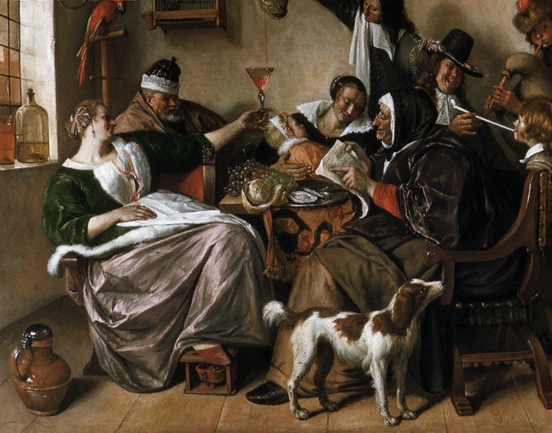
The Way You Hear It Is The Way You Sing It, Jan Steen
On Sunday, on another visit to New York City, I’m heading to the Frick with a couple friends from New Jersey to see the Vermeers and this painting in particular, on tour from the Royal Picture Gallery Mauritshuis in The Hague. At first glance I thought it was a remarkably precise Hals, for a number of reasons, but then discovered otherwise. It’s more or less an illustration of a Dutch proverb about parental responsibility, which more than one painter interpreted in similar scenes of domestic partying. The title comes from a Dutch proverb: ‘as the old sing, so pipe the young’ (soo voer gesongen, soo na gepepen). (What you do in front of the kids.) The motivation behind this sort of painting is almost the antithesis of what drives me to paint: it’s symbolic, narrative, moralistic, and essentially conceptual. Yet the way it’s executed, the color, and especially the light, is remarkable, at least in this photograph. I’m hoping they’re even more impressive when I’m standing in front of it.
November 20th, 2013 by dave dorsey
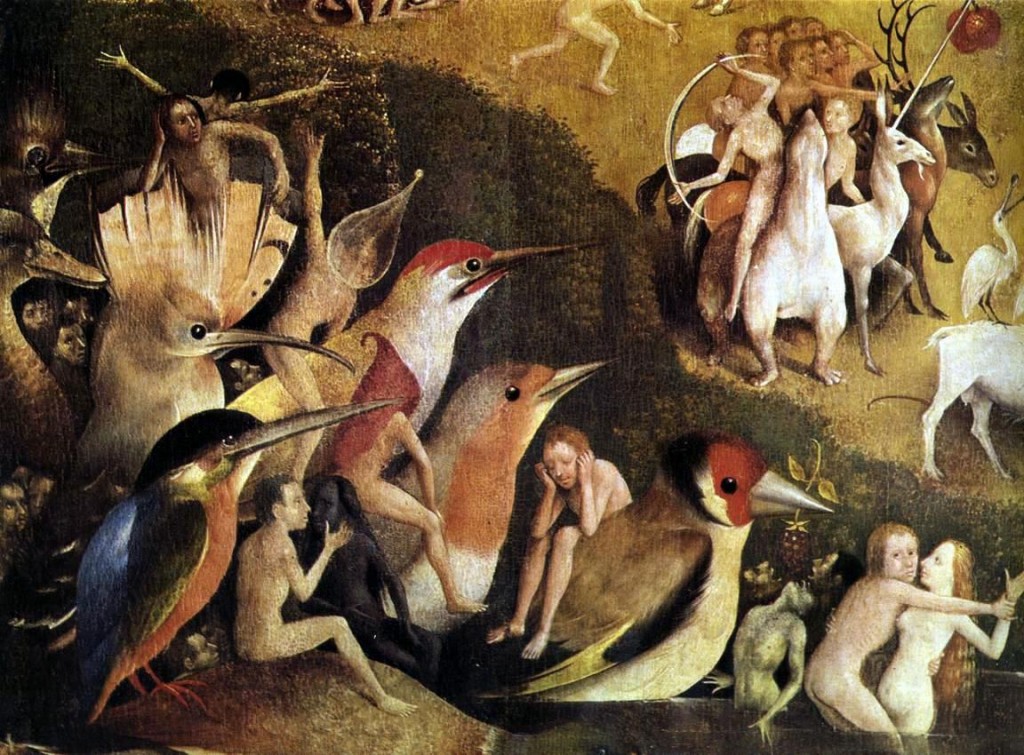
The Garden of Earthly Delights, detail, Hieronymous Bosch
“. . .just because you have looked at [a painting] does not mean that you have seen it. Just because something is available instantly to vision does not mean that it is available instantly to consciousness. Or, in slightly more general terms: access is not synonymous with learning. What turns access into learning is time and strategic patience.” –Jessica Lahey, The Atlantic
November 18th, 2013 by dave dorsey
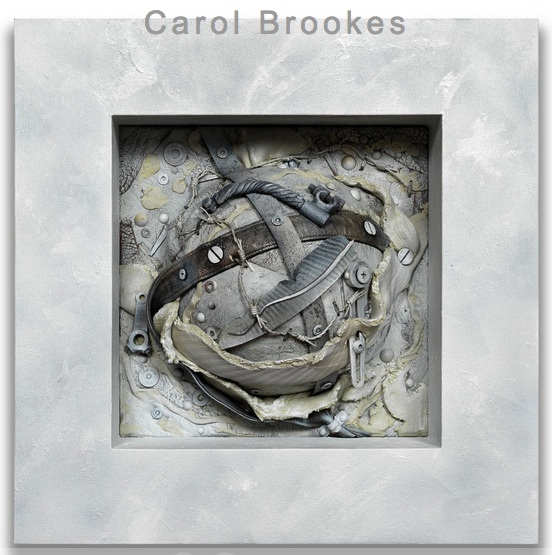
The amazingly prolific Carol Brookes, a fellow Viridian artist, has an opening Dec. 7 at Troy Fine Arts Services, in Southport, Connecticut.
November 15th, 2013 by dave dorsey

Nice of Jeep to make us aware of Mr. Dylan’s early adoption of Blind Willie Johnson. Dylan uses Johnson. Jeep uses Dylan. Something gets obscured the second time around, but not much, if you just quit looking at the flat screen. Does it make sense to watch a Cherokee moving around while Dylan sings about how God doesn’t treat him as well as a mother would? Not much. But I wouldn’t have heard the song without the commercial. I can’t afford a new Jeep, but I like the soundtrack to the invitation. Whenever I hear this recording from now on, I guarantee I will never think of a Jeep. Just as I never think of Volkswagen–though I do think of fireflies–when I hear “Pink Moon.”
November 13th, 2013 by dave dorsey
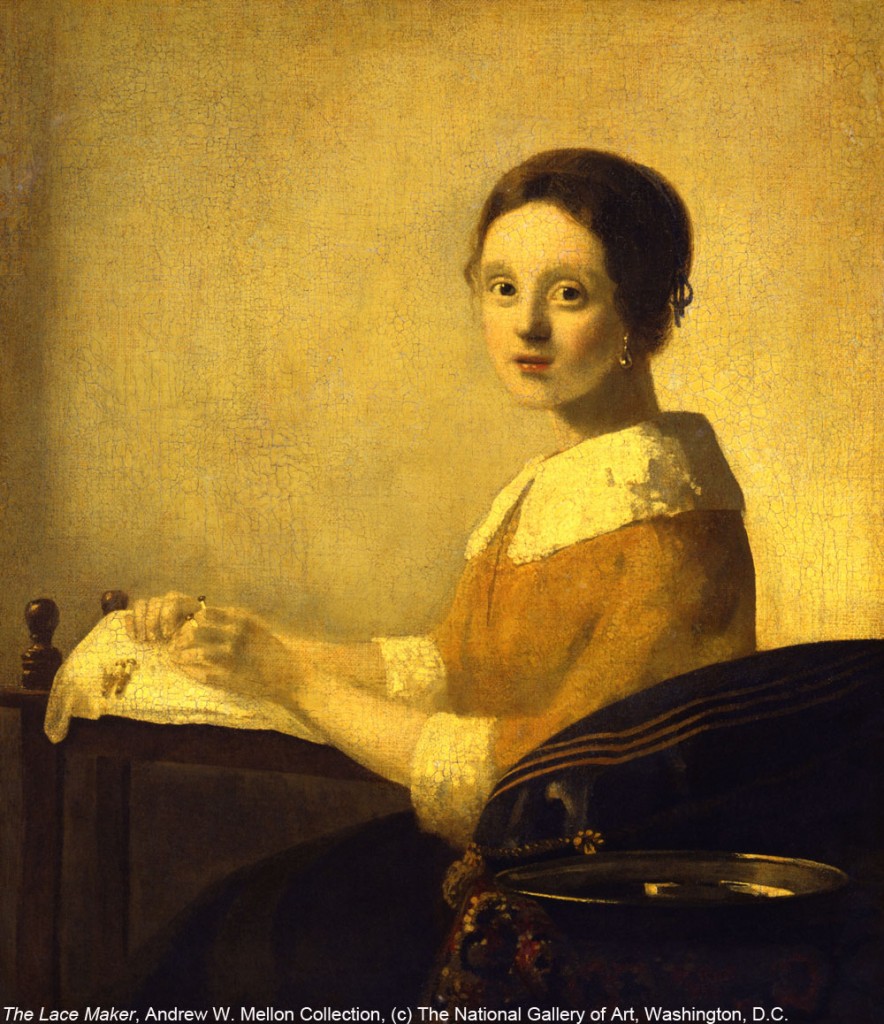
Vermeer forgery
This is quite nice, from Schjeldahl:
What do we see when we look at a painting? Decisions. Stroke by stroke, the painter did something rather than something else, a sequence of choices that add up to a general effect. If you’re like me—and, yes, I count myself a middling connoisseur—you register the effect and then investigate how it was achieved; walking the cat back, as they say in espionage. As a trick, ask yourself, of details in a painting, something like, “Why would I have done that in that way?” The aim is to enter into the mind, and the heart, of the creator. Attaining it entails trust, like that of a child attending a fairy tale.
Looking with this kind of absorption won’t immunize you to falling for a fake, but you are apt to be confused by false notes if the supposed artist’s style is familiar to you. The game then deepens. The forger hopes that, because you’re credulous, you will revise your estimation of the artist to accommodate the surprises. Or consider a reverse case: you’re told that an authentic work is a forgery. Paranoically, you view everything in it as sham. Again you’re bewildered, this time thrown into doubt about your powers of perception. You conclude that you’re a hopeless sucker.
To judge a work of art involves self-surrender.
You are something other than your own person when in art’s spell. If you dread being made a fool of, you will steer clear of art altogether. But risking foolishness, and succumbing to it occasionally, builds up antibodies of wisdom.
November 13th, 2013 by dave dorsey
 A list of artistic powerlessness du jour from Hyperallergic: brick and mortar galleries, anything that isn’t reheated modernism, photojournalists, negative critics, (wait, all critics), self-portraits (Instagram has it covered, thank you very much), and non-celebrity artists. (In other words, almost everything and all of us.)
A list of artistic powerlessness du jour from Hyperallergic: brick and mortar galleries, anything that isn’t reheated modernism, photojournalists, negative critics, (wait, all critics), self-portraits (Instagram has it covered, thank you very much), and non-celebrity artists. (In other words, almost everything and all of us.)
In other emerging news, cats maintain their effortless tyranny over the popular imagination.
Life’s unfair. Therefore, one paints. Work’s what’s kept us happy.
November 9th, 2013 by dave dorsey

David Salle
“One should not be selling something, but rather finding something. Just because something is a hit doesn’t make it interesting. The noble failure is often more enlightening than the thing with immediate appeal.” As told to Spencer Bailey —New York Times, print edition
November 7th, 2013 by dave dorsey

Pomplamoose 4, Ben Folds
Ben Folds is also a photographer, and the fact that it isn’t his main profession enables him to be refreshingly humble, simple and honest when he talks about how he doesn’t intend his work to mean anything. It’s always nice to hear someone say this. Painting has, for me, no intellectual component whatsoever. I paint what I want to look at repeatedly, without pinning down why. If the image causes me to become aware of more than the literal object or scene, all the better, but this isn’t something I can consciously make happen. The process is subconscious. The “meaning” of the picture, if it has such a thing, as well as the title, come later, when I extract or attach them in a parasitical way. James Hall, my dealer here in Rochester, always mocks my simple, literal titles. Two Pears. Candy Jar #10. It amuses him, but I never think to suggest that he ought to check the titles of thousands of paintings down through history. They add no more than mine to the visual power of the work. Mona Lisa. Starry Night. Sunflowers. Nothing that wouldn’t have been available from a glance at the painting itself. The Tempest, Bathsheba, Lunch on the Grass. . . Not detecting much in those titles that wasn’t there at a purely perceptual level, except maybe the Biblical reference.
(There are some profound exceptions of course. Guernica comes to mind, a painting with a clear purpose and meaning, which, like the significance of Kafka’s novels, expanded to include many horrors of the 20th century: death from the sky in the form of nuclear war. And now drones. Mostly conceptual art puts the cart before the horse, though in this case this process gets incredibly effective results. Guernica also happens to be one of the most perfectly titled paintings in history, the actual name of the town which was bombed, a place name that happens to include within it the word for the larger metaphorical subject of the painting itself: war.)
But to bring things back from this exception, Ben Folds talks about his photography:
I’ve been making photographs for most of my life and printing in the dark room, and it’s been an obsession. It’s the second showing I’ve had but also the first in a way because I printed them this time. I stood next to them (at the exhibition) and told people what I was thinking when I shot them. I don’t think about that. When I write a song I can already hear the questions about it and I don’t like that I think that way. I just feel where it’s going. I enjoy trying to remember why I shot something. Sometimes it was just because it was . . . purty. (With that word Folds mimicked the voice of the backwoods assailant who says, purty lips in Deliverance.) When the kids were born I did the typical thing of taking ten thousand shots with a digital camera, and I thought nobody wants to see this shit. So I started taking printing seriously. I shot on tour and I just mailed off to a storage space and we ended up with four or five big stacks of negatives and contact sheets and I thought I really must be crazy. It’s a lot of work. It’s kept me sane. I would spend from five in the morning to one in the afternoon in the dark room and from then on to midnight in the studio. My mother’s a good artist, a painter. My parents didn’t play music. So music was less likely than photography was. I shoot what feels right. “The light is kinda cool. This will look good on film.” The meaning is just an add-on, side-effect, that I don’t even realize. I’m not aware of it. It’s just for the gallery. That’s all it is. It’s for the show when you’re standing there with the wine. When you’re creating something you really don’t know why you have to do it. You’re not making a Hallmark card. Which is a great thing too. I don’t write songs that way. I don’t write topically. But people ask me questions (about a song) and I’ve explained it, so Im fucked. With photography I’m still innocent.
I especially like: “I must be crazy. It’s kept me sane.” An artist!
November 5th, 2013 by dave dorsey

The Scream, as a t shirt
Greg Proops on Kevin Pollak’s Chat Show:
“This year I did Oslo, Amsterdam, Paris . . . I try to take it all around. There’s always an English-speaking crowd. We did a show in Oslo. We went to the Munch Museum. He painting The Scream, the most abject depiction of terror and despair in the face of modern alienation. Of course they sell Scream erasers, Scream bicycle reflectors, Scream everything, pencils, hilarious. Of all the things you want to see all around you all the time is the I-can’t-handle the-world anymore moment. They have Munch for children on the weekends.”
November 2nd, 2013 by dave dorsey

Fairfield Porter, Self-Portrait
“What we’re worried about forgetting … tends to be quite particular. It isn’t just anything about a person or scene that’s at stake; we want to remember what really matters, and the people we call good artists are, in part, the ones who appear to have made the right choices about what to communicate and what to leave out. … We might say that good artwork pins down the core of significance, while its bad counterpart, although undeniably reminding us of something, lets an essence slip away. It is an empty souvenir.”
“Art holds out the promise of inner wholeness.”
—Alain de Botton
November 1st, 2013 by dave dorsey
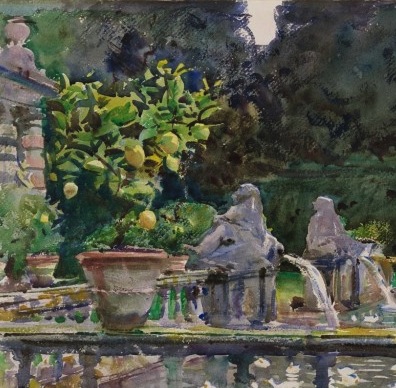
John Singer Sargent, Villa di Marlia, Lucca: A Fountain
I’ve always thought the watercolors Sargent began showing in his 50s are his greatest work, when he finally began to grapple with color. What looks like a tremendous show at the Museum of Fine Arts in Boston offers a chance to look at 90 examples:
From The New Yorker:
The way in which he could just summarize optical effects is what boggles the mind,” Carbone said. With the eraser end of a pencil, she pointed to the back of one of the statues. Its shadowed curve is the color of dark wood in water, while behind it a sunlit plant is an explosion of yellow-green, the color of a light-skinned lime. “This kind of thing,” she said, “it’s crazy!”
Sargent’s watercolors, Carbone explained, were painted in a “spectacular shorthand”: “He was a master of corrective technique—he could make alterations where an amateur couldn’t.” We stopped in front of “A Tramp,” which Sargent made sometime around 1906. A bearded man, his skin tan and weathered, seems to emerge from a forested background. His face, and especially his eyes, are clearly defined, but below his elbows the painting becomes vague and abstract, as if in a fog. Carbone pointed to the lower-left corner, a blur of green and gray. “This area was a puddled area of wash that he just wiped off,” she said. “You can even see the stroke marks.” The blurred area seemed a little punk-rock. In a sense, Sargent had defaced his own art, but the hint of casualness only makes the painting seem more accomplished.
In 1907, at the age of fifty-one, Sargent announced his retirement from the kind of society portraiture that, with the help of some judicious investments, had made him so prosperous. By then, he had already begun painting watercolors outside of the studio, en plein air. At first, Carbone explained, he painted the watercolors for himself. “In his studio, apparently, he had stacks and stacks of them, just in piles. People describe parts of his house with stairways lined with framed watercolors. He would give them as presents—there’s this joke that people would get engaged just so they could get a Sargent watercolor.” (“These sketches keep up my morale,” he told a friend, “and I never sell them.”) Eventually, though, he grew serious about exhibiting and selling them, and came to see the watercolors as a body of work in their own right.













